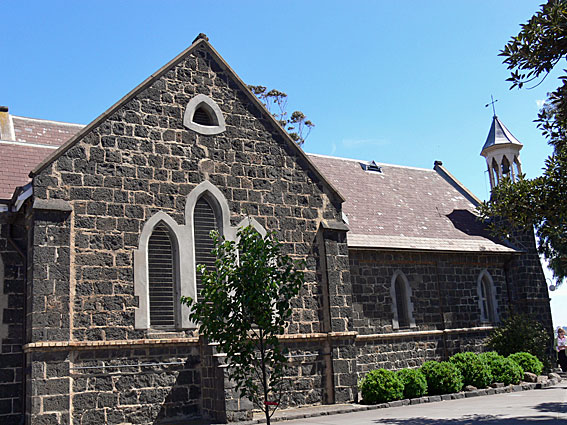
Christ Church Anglican Church, Hawthorn, Victoria: the exterior
(photograph by John Maidment [9 November 2010])

Christ Church Anglican Church, Hawthorn, Victoria: the exterior
(photograph by John Maidment [9 November 2010])
Historical and Technical Documentation by John Maidment
© OHTA, 2010 (last updated December 2019)
The initial parts of Christ Church were erected in 1853-54 to the design of Charles Vickers. Later additions were made in 1873 (chancel and temporary organ chamber) and in 1886 (extension of nave and addition of north transept). The current organ chamber was erected in 1897 and vestries were added in 1953.1 The church was constructed in bluestone in an Early-English Gothic idiom and has a small bellcote to the left of the main facade. The interior fittings include a richly carved chancel screen and fine stained glass, particularly a three-light window in the south transept by John Hardman & Sons that is very similar stylistically to the west windows in St Patrick's Cathedral, Melbourne and Holy Trinity Church, Coleraine.
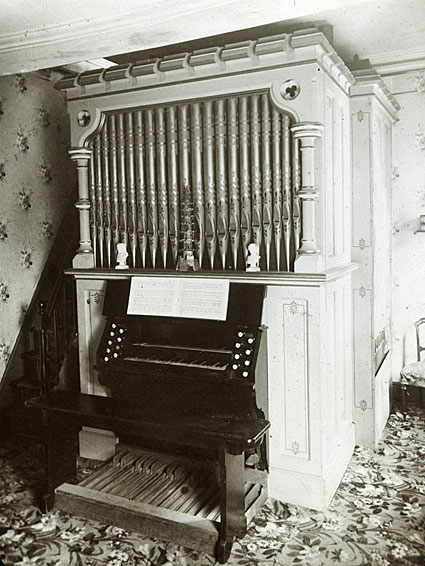
Residence of Robert Sperring, Essendon, showing the Walker casework of 1855
(photograph from the State Library of Victoria, accession no: H86.108/242)
The first organ was built by J.W. Walker, London in 1855 as the firm's job number 536, and was ordered by Charles J. Latrobe Esq, 33 Ely Place, Holborn (former Lieutenant-Governor of Victoria). This was a single manual instrument of five stops and cost £112-12-0.2 It was erected on a gallery at the rear of the church, but was sold in 1876 for £120 probably to organbuilder William Anderson who erected the later Hunter organ. It was used as the basis for a two-manual organ built for the residence of Robert Sperring in Essendon and later enlarged to three manuals for his home 'Tooronga' at 6 Aberfeldie Street, Essendon.3 The organ was advertised for sale in 1894 and has presumably been broken up. The Walker casework is identical to the organs at St Paul's Presbyterian Church, Mudgee, NSW and St Luke's Anglican Church, Wallsend, NSW, both of the same date as the Hawthorn organ.
| MANUAL Open Diapason Dulciana Stop Diapason Bass Stop Diapason Treble Principal Fifteenth |
8 8 8 8 4 2 |
|
Compass from GG to F in alt including GG#
One octave & half of German Pedals GG to D
Two composition pedals to bring on –
1st Open & Stop Diapn Bass & Treble & Dulciana
2nd Full power
The whole enclosed in a neat Deal Gothic case, stained & varnished with gilt pipes in the front,- abt 10ft high 6ft 6in wide & 4ft deep.4
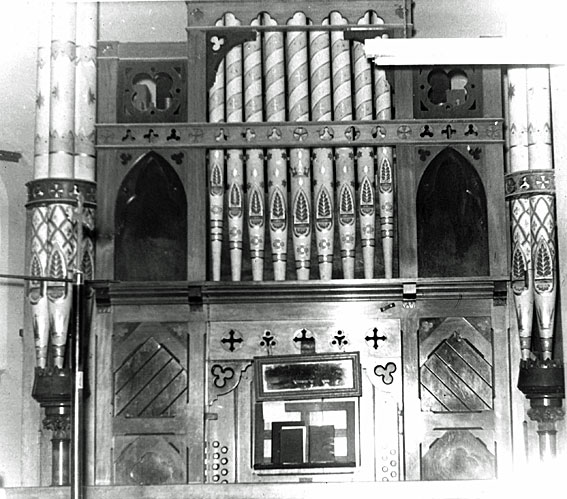
Christ Church Anglican Church, Hawthorn: the organ before the 1968 work
(photograph by John Maidment [1966])
The present organ was built in 1876 by Alfred Hunter, 379, Kennington Rd., London and was opened on 12 September 1877.5 The total cost was £495. It is unclear why Hunter was chosen to build the organ although he and George Fincham worked together at J.C. Bishop's factory in London. However, the organ was installed by William Anderson, so this connection may be tenuous.
| GREAT Open Diapason Stopped Diap Bass Clarabella Dulciana Principal Flute Twelfth Fifteenth Mixture Trumpet Swell to Great SWELL Sw Double Diapason Sw Open Diapason Sw Stopped Diapason Sw Principal Gamba Sw Mixture Sw Fifteenth Sw Oboe Sw Cornopean PEDAL Bourdon Great to Pedals Swell to Pedals |
8ft 8ft 8ft 8ft 4ft 4ft 2-2/3ft 2ft 3 ranks 8ft 16ft 8ft 8ft 4ft 8ft 2 ranks 2ft 8ft 8ft 16ft |
CC-BB TC TC TC added 1877 added 1877: 15.19.22 added 1877 [Clarionette 8ft, with Bassoon bass] bass outside swell box gvd.bass added 1877 TC, formerly on Great added 1877: 19.22 added 1877 |
Compass: 56/30
3 composition pedals
Tremulant by trigger pedal (original swell pedal)
Balanced swell pedal
Attached drawstop console6
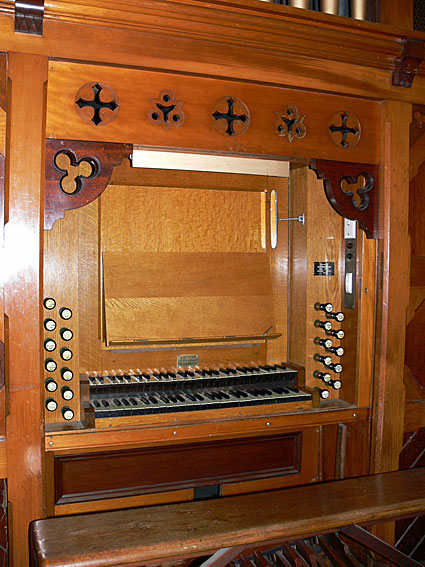
Christ Church Anglican Church, Hawthorn: console
(photograph by John Maidment [9 November 2010])
The organ was restored in 1968 by Hill, Norman & Beard (Australia) Pty Ltd, who replaced the Hunter strip music desk with a solid oak desk and painted out the original pipe stencilling, evident in a photograph taken c.1966, also filling the openings on either side of the central flat with bronze mesh7. In around 1983 George Fincham & Sons Pty Ltd carried out a renovation, with some revoicing taking place.
This organ sadly is placed in a deeply recessed organ chamber where much of the sound fails to escape into the nave from where it is invisible. The choruses are complete up to Mixtures that only contain quints and unisons, and the Cornopean adds a great deal to the full sound. The casework, too, is highly distinctive, and is possibly architect-designed; it has prominent pierced transom rails and an unusual pierced frieze above the console, the design of the latter being copied by William Anderson on a number of his instruments.
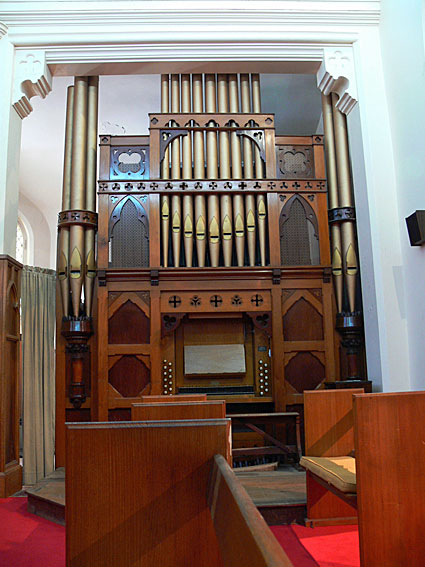
Christ Church Anglican Church, Hawthorn: case after 1968 work
(photograph by John Maidment [9 November 2010])

Christ Church Anglican Church, Hawthorn: Hunter nameplate
(photograph by John Maidment [9 November 2010])
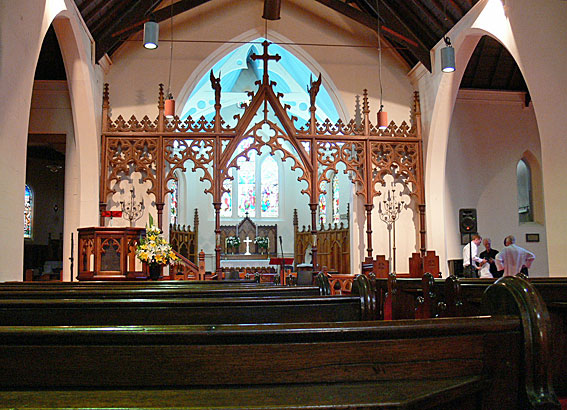
Christ Church Anglican Church, Hawthorn: church interior looking east
(photograph by John Maidment [9 November 2010])
1 Victorian Churches, edited by Miles Lewis. East Melbourne: National Trust of Australia (Victoria), p.73
2 Information from the order books of J.W. Walker, courtesy of J.W.Walker & Sons Ltd, Brandon, Suffolk supplied to Hampton Beale, Christ Church organist
3 Details and photographs from the archives of the Essendon Historical Society. Photographs of this instrument are also held by the State Library of Victoria.
4 Walker order books
5 The Argus, 13 September 1877, p.5
6 Specification noted by John Maidment 1966 and 2010
7 Details of the Hill, Norman & Beard work noted by John Maidment 1968